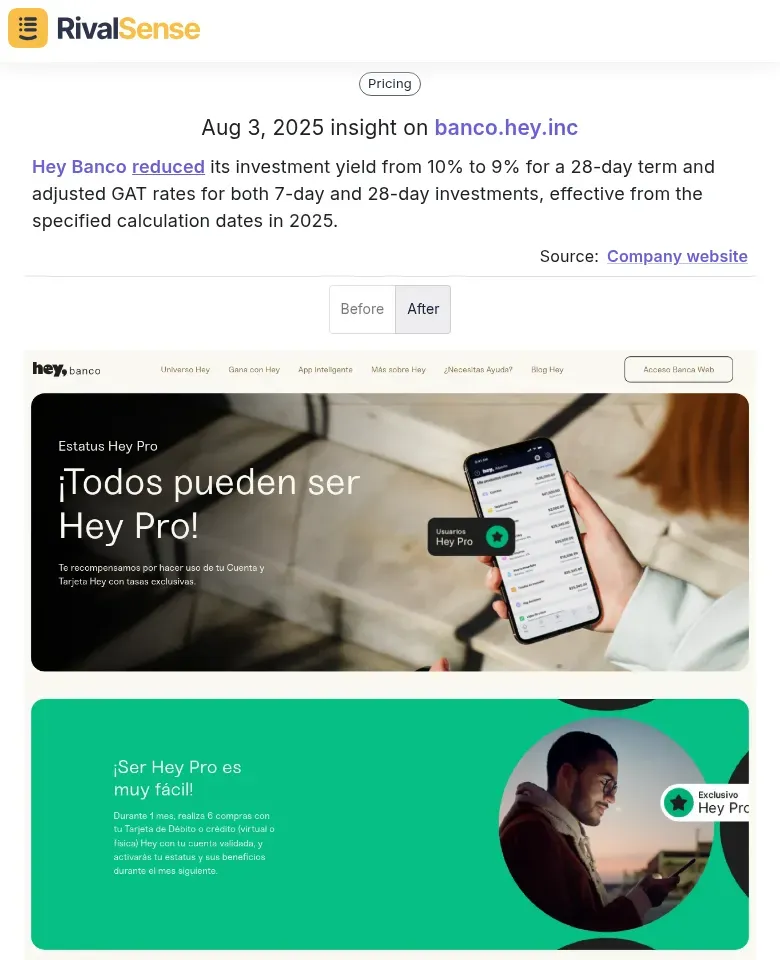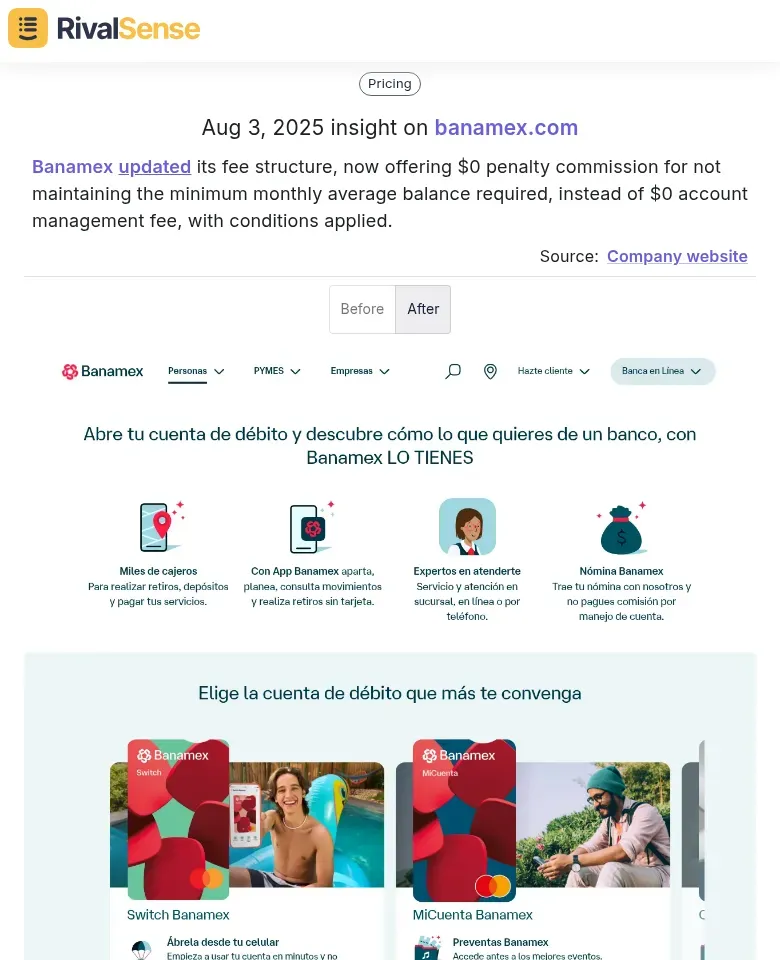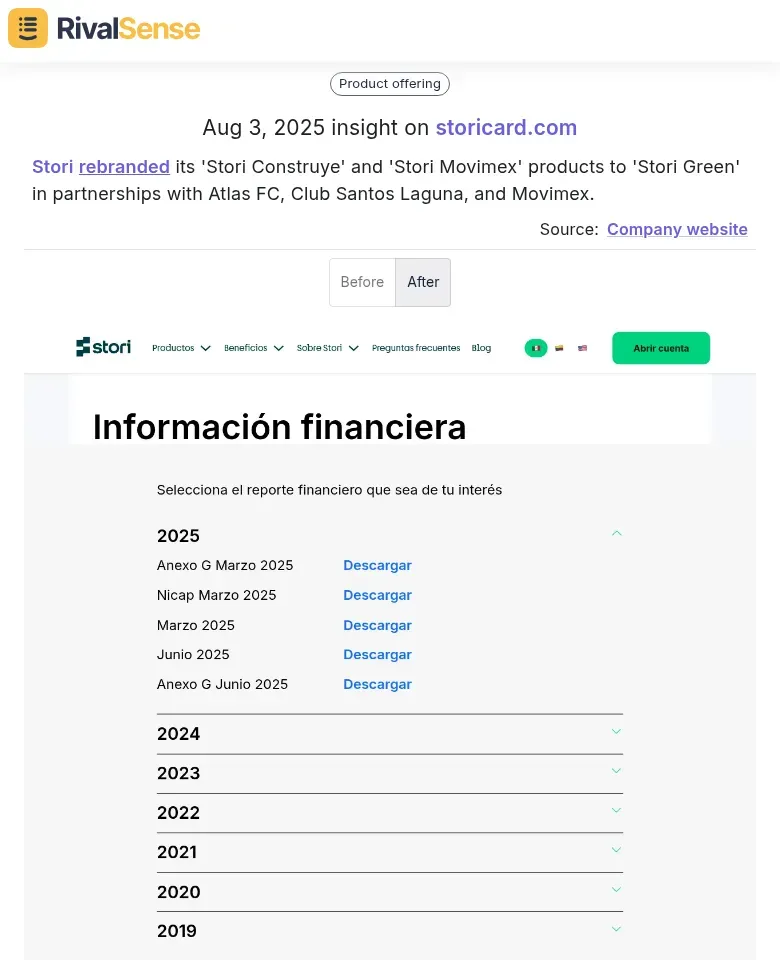Practical Competitive Research: A Step-by-Step Guide for Business Leaders
In today's fast-paced business environment, staying ahead requires more than just knowing your competitors' names. Practical competitive research turns raw data into strategic advantages by revealing actionable insights about rivals' moves. This guide delivers step-by-step methods to systematically uncover opportunities and threats.
Step 1: Identify Your Competitors 👥
Start by mapping your competitive landscape across direct and indirect players. Direct competitors offer similar solutions, while indirect ones solve the same customer problems differently. Tip: Use automated tools to continuously track emerging competitors across markets.
Step 2: Analyze Competitor Products & Services 💼
Examine feature updates, pricing shifts, and unique value propositions. Real-time tracking of changes helps spot market gaps. For example, when Hey Banco reduced investment yields:

Monitoring such pricing changes helps benchmark your offerings and anticipate customer churn. Notice how even minor adjustments can signal strategic shifts.
Step 3: Study Their Marketing Strategies 📢
Audit their content, social engagement, and campaign tactics across channels. Checklist:
- ✅ Blog/whitepaper topics
- ✅ Social media engagement patterns
- ✅ Paid ad messaging
- ✅ Email marketing approaches
Step 4: Evaluate Financial Indicators 📈
Assess pricing structures and fee changes as proxies for financial health when reports are unavailable. Consider how Banamex restructured fees:

Zero-commission models like this reveal customer acquisition strategies and margin pressures in your sector.
Step 5: Monitor Online Reputation 🌐
Analyze review patterns on G2/Trustpilot to identify service weaknesses. Hint: Track sentiment trends quarterly to spot emerging issues.
Step 6: Track Partnerships & Collaborations 🤝
Alliances often preview market expansions or strategic pivots. When Stori rebranded products through sports partnerships:

Such collaborations signal brand repositioning (e.g., sustainability focus) and new audience targeting worth monitoring.
Step 7: Stay Updated on Regulatory Changes ⚖️
Compliance shifts create industry-wide risks or advantages. Automate tracking of licensing updates and policy announcements.
Step 8: Compile Findings with SWOT 🔍
Organize insights into:
| Strengths | Weaknesses |
|---|---|
| Their advantages | Their vulnerabilities |
| Opportunities | Threats |
| Your differentiators | Market risks |
Step 9: Implement & Iterate 🔄
Turn analysis into action through:
- Quarterly strategy reviews
- Tactical response plans
- Automated monitoring systems
Final Thoughts
Consistent competitive research transforms market noise into growth opportunities. By detecting moves like pricing adjustments, rebrands, and partnership shifts early, you gain strategic reaction time.
Ready to automate your competitive tracking? ➡️ Try RivalSense for free and get your first competitor report today!
📚 Read more
👉 Optimizing Telehealth: Researching Competitor Ecosystems Guide
👉 How Phrase's AI Focus Spurred RivalSense's Global Strategy Shift
👉 Predictive Competitor Analysis: Turning Internet Insights into Strategic Wins
👉 Beginner’s Guide to Tracking AI Competitors Like Dust
👉 Competitor Product Insights: A Strategic Tool for Boosting Analyst Relations
